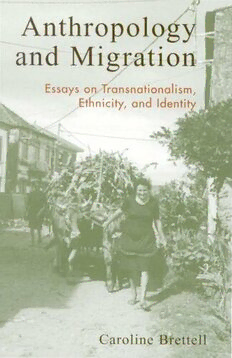
Anthropology and Migration; Essays on Transnationalism, Ethnicity, and Identity PDF
Preview Anthropology and Migration; Essays on Transnationalism, Ethnicity, and Identity
· J ,; Anthropology an d Migration Essays on Transnationalism , Ethnicity, and Identltv Carol ine Btettell ANTHROPOLOGY AND MIGRATION ANTHROPOLOGY AND MIGRATION Essays on Transnational ism, Ethnicity, and Identity Caroline Brettell PRESS A Division of Rowman & Littlefield Publishers, Inc. Walnut Creek • Lanham • New York • Oxford ALTAMlRA PRESS A Division of Rowman & Littlefield Publishers, Inc. 1630 North Main Street, #367 Walnut Creek, CA 94596 www.altamirapress.com Rowman & Littlefield Publishers, Inc. A Member of the Rowman & Littlefield Publishing Group 4501 Forbes Boulevard, Suite 200 Lanham, Maryland 20706 PO Box 317 Oxford OX29RU, UK Copyright © 2003 by ALTAMlRA PRESS All rights reserved. No part of this publication may be reproduced, stored in a retrieval system, or transmitted in any form or by any means, electronic, mechanical, photocopying, recording, or otherwise, without the prior permission of the publisher. British Library Cataloguing in Publication Information Available Library of Congress Cataloging-in-Publication Data Brettell, Caroline. Anthropology and migration: essays on transnationalism, ethnicity, and identity / Caroline Brettell. p.cm. Includes bibliographical references and index. ISBN: 978-0-7591-0320-7 1. Portuguese-Foreign countries-History. 2. Portugal-Emigration and immigration-Social aspects. 3. Return migration-Portugal-History. 4. Identity (Psychology)-Portugal. 5. Ethnicity-Portugal. 1. Title. DP534.5.B742003 305.86'9'009-dc21 2003006176 Printed in the United States of America §TM The paper used in this publication meets the minimum requirements of American National Standard for Information Sciences-Permanence of Paper for Printed Library Materials, ANSI/NISO Z39.48-1992. Contents List of Tables vii Introduction: Anthropology, Migration, and the Portuguese Diaspora ix PART I: SITUATING THE ANTHROPOLOGICAL PERSPECTIVE: MACRO, MESO, AND MICRO APPROACHES TO THE STUDY OF MIGRATION 1 1 The Emigrant, the Nation, and the State in Nineteenth- and Twentieth-Century Portugal: An Anthropological Approach 9 2 Migration Stories: Agency and the Individual in the Study of Migration 23 PART II: RETURN MIGRATION, TRANSMIGRANTS, AND TRANSNATIONALISM 47 3 Emigrar para Voltar: A Portuguese Ideology of Return Migration 57 4 Emigration, the Church, and the Religious Festa in Northern Portugal 75 v vi / Contents PART III: CITIES, IMMIGRANT COMMUNITIES, AND ETHNIC IDENTITY 101 5 Is the Ethnic Community Inevitable?: A Comparison of the Settlement Patterns of Portuguese Immigrants in Toronto and Paris 109 6 Ethnicity and Entrepreneurs: Portuguese Immigrants in a Canadian City 127 PART IV: GENDER AND MIGRATION 139 7 Emigration and Household Structure in a Portuguese Parish, 1850-1920 153 8 Women Are Migrants, Too: A Portuguese Perspective 185 9 Conclusion: Toward a Comparative Understanding of Migration 197 References 201 Index 233 About the Author 239 List of Tables Table 3.1. Portuguese Legal Immigration to France, 1946-1975 58 Table 4.1. Rates of Migration and Sex Ratios in Lanheses, 1864-1970 77 Table 4.2. Portuguese Emigration by District of Origin, 1950-1974 79 Table 4.3. Residents of Lanheses Living in France, 1975 79 Table 4.4. Baptisms in Lanheses for Children Born in France to Native Lanhesan Parents, 1967-1977 82 Table 4.5. Receipts and Expenses for Special Festas in Lanheses, 1964-1978 86 Table 5.1. Portuguese Immigration to Canada, 1946-1973 111 Table 5.2. Portuguese Immigration to France, 1946-1979 111 Table 5.3. Foreign-Born Population of Metropolitan Toronto and Some Proximate Suburbs, 1971 113 Table 5.4. Distribution of the Foreign Population of Paris, by Arrondissement, 1975 117 VII viii / List of Tables Table 5.5. Distribution of Portuguese Immigrants in Paris, by Sex and Arrondissement, 1975 118 Table 7.1. Distribution of Household Types in Lanheses, 1850-1920 160 Table 7.2. Coresidence of Single Women, by Age, 1850-1920 164 Table 7.3. Coresidence of Married Women, by Age, 1850-1920 170 Table 7.4. Simple and Multiple Households with Male Absences, 1850-1920 174 Table 7.5. Female-Headed Households, by Age and Type, 1850-1920 175 Table 7.6. Coresidence of Widows, by Age, 1850-1920 177 Introduction Anthropology, Migration, and the Portuguese Diaspora Anthropology, as a discipline, came relatively late to the study of migra tion as a social, political, economic, and cultural process. Indeed, anthro pologists often chose not to write about it, even when it was happening right in front of them, because it did not fit the timeless and bounded idea of culture that framed their analyses. For example, while it has been estimated that approximately 52 percent of the Chambri (Tchambuli) men between the ages of fifteen and forty-five were working as migrant laborers and therefore absent from the Papua New Guinea village where Margaret Mead was living in 1933, she "did not take these articulations with the larger system into consideration" (Gewertz and Errington 1991, 87). Similarly, although George Foster (1967) acknowledged that some residents of the Mexican village of Tzintzuntzan, where he carried out field research in the mid-1940s, were involved in the bracero program, he leaves the significant impact of migration out of his model of the "image of limited good." However, by the late 1950s and early 1960s, it became apparent to many anthropologists that migration should receive more systematic at tention as a topic for research. Initially the emphasis was on rural-urban migration, the demographic factor that most contributed to the exponen tial growth of cities such as Mexico City, Cairo, Jakarta, Lagos, Nairobi, Lima, Sao Paolo, and Rio de Janeiro. Migration was a manifestation of a pervasive transformation from a rural agrarian base to an urban indus trial base in the economies of most developing countries (Safa 1975). In the emerging cities of South and Southeast Asia, Africa, and Central and South America, rural villagers were finding employment as unskilled or semiskilled workers and were living in neighborhoods with people of ix
